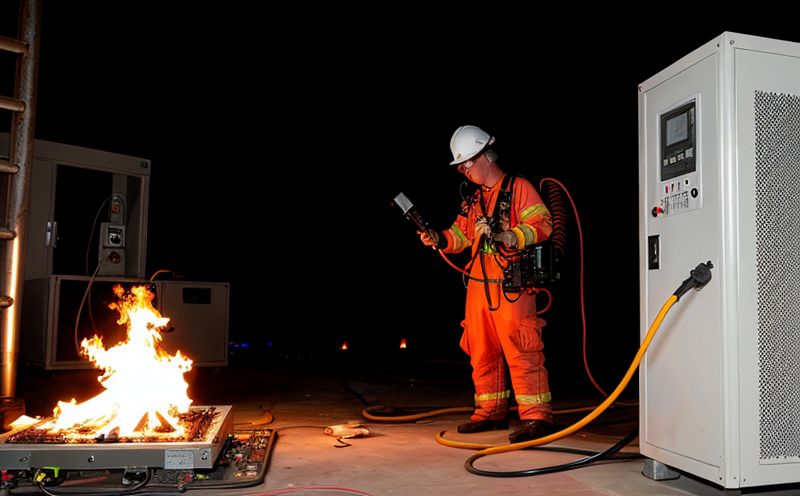UL 746E Standard for Polymeric Materials – Electrical and Electronic Components
The UL 746E standard is a critical component in ensuring electrical and electronic components made from polymeric materials are safe, reliable, and perform optimally under various environmental conditions. This standard is particularly important as it addresses the flammability characteristics of these materials which can have significant implications for product design and safety.
UL 746E provides a framework to evaluate the burning behavior of polymeric materials used in electrical and electronic components, including insulation, housings, and connectors. The standard is designed to ensure that the products meet stringent fire safety requirements, thereby protecting consumers and users from potential hazards associated with flammable materials.
The testing process involves subjecting specimens to a series of controlled ignition tests to assess their flame spread characteristics. This includes determining the rate at which flames spread across the surface of the material and observing any dripping or melting behavior that could pose additional fire risks. Compliance with UL 746E is not only about meeting regulatory requirements but also enhancing consumer trust in products.
The standard is applicable to a wide range of polymeric materials commonly used in electrical and electronic devices, such as PVC, ABS, polycarbonate, and various types of flame retardant polymers. By adhering to this standard, manufacturers can ensure their products meet the highest safety standards and are prepared for global markets where stringent fire safety regulations are enforced.
- Flame Spread Index: This metric evaluates how quickly flames spread across the surface of a material when exposed to an ignition source. A lower flame spread index indicates better performance in terms of fire resistance, which is crucial for electrical and electronic devices that could be exposed to heat sources or open flames.
- Drip and Melt Behavior: The standard also assesses whether the material drips or melts under high temperatures. Dripping can lead to a pool of flammable liquid near the source, increasing fire risk, while melting can cause the component to deform, potentially leading to electrical short circuits.
In summary, UL 746E is more than just a compliance requirement; it is a benchmark for ensuring product safety and reliability. Compliance with this standard helps manufacturers differentiate their products in a competitive market by demonstrating superior quality and adherence to international standards.
Quality and Reliability Assurance
The UL 746E standard plays a pivotal role in the overall quality assurance process for electrical and electronic components. By adhering to this standard, manufacturers can ensure that their products are not only safe but also reliable under various operating conditions.
One of the key aspects of ensuring quality through compliance with UL 746E is consistent specimen preparation. This involves carefully selecting and preparing samples according to specific guidelines provided in the standard. Proper sample preparation ensures that the results obtained from testing are accurate and representative of the material's actual performance.
The testing process itself is highly controlled, involving precise calibration of equipment such as calorimeters used for measuring heat release rates and oxygen index testers for determining the flammability properties of materials. These instruments must be regularly calibrated to maintain accuracy and reliability throughout the testing cycle.
Once tested, detailed reports are generated outlining the performance metrics of each specimen. These reports serve as a comprehensive record of the product's compliance with UL 746E standards. They provide valuable insights into any areas where improvements can be made, helping manufacturers refine their processes and enhance product quality.
Compliance with UL 746E also contributes to long-term reliability by ensuring that materials do not degrade over time due to exposure to heat or other environmental factors. This is particularly important for electronic devices which may operate in demanding environments such as industrial settings or high-temperature applications.
Environmental and Sustainability Contributions
- Sustainable Materials: The use of UL 746E compliant materials supports the trend towards more sustainable manufacturing practices. By selecting polymeric materials that meet stringent fire safety standards, manufacturers contribute to reducing the environmental impact associated with product failures due to fire risks.
- Eco-friendly Manufacturing: Adherence to this standard encourages eco-friendly manufacturing processes by promoting the use of safer and more sustainable materials throughout the supply chain. This not only reduces waste but also minimizes harmful emissions during production.
By prioritizing compliance with UL 746E, manufacturers can help drive innovation in material science that focuses on creating products that are both safe and environmentally responsible. This aligns closely with global efforts to promote sustainable development within the electronics industry.
Competitive Advantage and Market Impact
- Innovation Leadership: Compliance with UL 746E demonstrates a commitment to innovation and excellence in product design. It showcases that the manufacturer is at the forefront of fire safety technology, setting a benchmark for industry standards.
- Global Market Access: In an increasingly globalized market, meeting international standards like UL 746E opens doors to new markets where stringent fire safety regulations are in place. This can significantly enhance market access and competitiveness.
The standard also fosters a culture of continuous improvement within organizations, encouraging ongoing research into safer and more efficient materials for electrical and electronic components. This proactive approach not only enhances product reliability but also positions the company as a leader in sustainable manufacturing practices.





